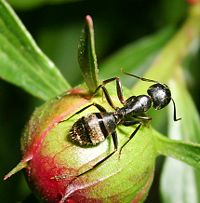Animal: Difference between revisions
imported>Joshua Choi No edit summary |
imported>Joshua Choi |
||
| Line 145: | Line 145: | ||
Because animals are [[heterotroph]]s, they act as [[consumer]]s in whatever [[ecosystem]]s they live in. They are often found at the higher [[trophic level]]s of their ecosystems' [[food web]]s: [[herbivore]]s eat [[plant]]s and other [[producer]]s, [[carnivore]]s and [[omnivore]]s eat other consumers, and [[detrivore]]s feed on any [[detritus|dead organisms]]. For the vast majority of animals, the usable [[energy]] that animals need to sustain their [[metabolism]] and stay alive originally comes from the [[Sun]]. This energy was captured by producers like plants with [[photosynthesis]], which is turn transferred to whatever animals eat them. | Because animals are [[heterotroph]]s, they act as [[consumer]]s in whatever [[ecosystem]]s they live in. They are often found at the higher [[trophic level]]s of their ecosystems' [[food web]]s: [[herbivore]]s eat [[plant]]s and other [[producer]]s, [[carnivore]]s and [[omnivore]]s eat other consumers, and [[detrivore]]s feed on any [[detritus|dead organisms]]. For the vast majority of animals, the usable [[energy]] that animals need to sustain their [[metabolism]] and stay alive originally comes from the [[Sun]]. This energy was captured by producers like plants with [[photosynthesis]], which is turn transferred to whatever animals eat them. | ||
Animals are important links in many | Animals are also important links in many [[biochemical cycle]]s. In the [[carbon cycle|carbon]] and [[oxygen cycle]]s, for instance, animals consume the [[oxygen]] gas produced by plants' photosynthesis and use it in [[aerobic respiration]], producing [[carbon dioxide]] gas. Carbon dioxide is in turn required for photosynthesis—in this way plants and animals rely on each other for the [[carbon]] they require to [[grow]]. Animals free up the carbon that plants are made of by eating, burning, and exhaling carbon dioxide into the Earth's [[atmosphere]] and [[hydrosphere]]. Plants capture this airborne carbon and use it to build themselves up. | ||
==Impacts on humans== | ==Impacts on humans== | ||
Revision as of 23:48, 2 April 2009
| Animals | ||||||
|---|---|---|---|---|---|---|
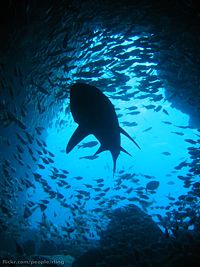 This grey nurse shark (Carcharias taurus) and the smaller fish surrounding it are animals.
| ||||||
| Scientific classification | ||||||
| ||||||
| Phyla | ||||||
|
Infrakingdom Eumetazoa
|
The animals (from the Latin animale and anima, meaning "vital breath") are those organisms classified into the kingdom Animalia. Together they make up a wide segment of life—biologists estimate their species to number many millions—and include an incredibly diverse array of both familiar and strange creatures, ranging from hawks to humans and sea slugs to spiders. Nonetheless, they all share certain characteristics: all animals are multicellular eukaryotes and also ingest their food and move by their own power at some point in their life cycle. Animals are essential consumers in many ecosystems and many are also important in human societies and economies.
Characteristics
Cells and tissues
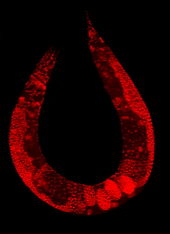
Like plants and fungi, all animals are eukaryotic: they are comprised of cells which contain a nucleus. However, their cells lack cell walls that surround the cells of plants and fungi. Unlike bacteria, archaea and most protists, they are also multicellular: their bodies are made of many cells attached to one another.
Animal cells are organized into specialized, integrated arrangements called tissues, which may in turn be organized into larger structures called organs. All animals have a tissue type called epithelium, a protective layer of cells covering their bodies' surfaces.[1] Many animals also share other structures such as guts (chambers with one or more openings for digestion), muscles (organs which contract for locomotion), and nerves (tissues which transmit signals between cells).
All of an animal's tissues originally develop from one, two, or three tissue layers in the embryo stage, depending what kind of animal it be. Sponge embryos have but one layer, while diploblasts have two and triploblasts have three. In diploblasts and triploblasts, the inner layer is called the endoderm (which develops into the gut and associated tissue) and the outer layer is called the ectoderm (which develops into skin and the nervous system). Triploblasts also have a layer in between called the mesoderm, which develops into many internal organs such as the circulatory system, muscle, and bone.
Food and energy
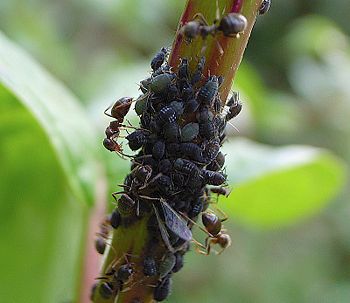
In one of the many unique ways animals obtain food, rancher ants drink sugary juice from aphids in return for the aphids' protection.
Another trait common to all animals is that they are heterotrophs: they obtain nutrients by ingesting food from outside, generally digesting food in an internal chamber. This separates them from plants, algae, and other autotrophs, which do not ingest food. They are consumers that often occupy the higher levels of food chains in many ecosystems.[1] They obtain their food in a dazzling array of methods: for instance, rancher ants tend aphids and harvest the sugar that they secrete. [2]
Animals obtain food in many ways, but most can be grouped into two types. The first, predation is a biological interaction where a heterotroph, called the predator, obtains food by consuming the cells of another organism, called the prey. Predators are further split into three groups. Herbivores are predators that primarily consume autotrophs, carnivores are predators that primarily consume heterotrophs, and omnivores are predators that consume both autotrophs and heterotrophs.
Many animals also practice detritivory, where an animal consumes food from detritus: dead organic matter. Like detritivore bacteria and fungi, detritivore animals recycle nutrients and are thus important in decomposition.
The ways that animals feed on the food they obtain may be grouped into four general tactics. Suspension feeding, or filter feeding, filters out and concentrates food particles suspended in water or air, such as a baleen whale filtering out plankton. Deposit feeding swallows a substrate and ingests the microorganisms, detritus, and other cells within the substrate, such as an earthworm eats through soil. Fluid feeding sucks fluids such as body fluids from plants and animals, such as a butterfly drinking a flower's nectar. Mass feeding, or bulk feeding, eats chunks of flesh from prey into the mouth, such as a snail eating pieces of leaves. [1]
Locomotion and limbs
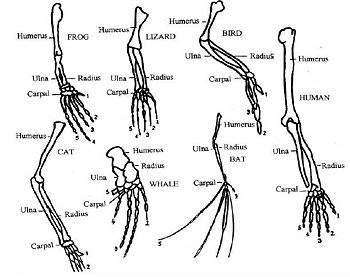
One final common trait of animals is that they are motile during at least one point of their life cycle. Even the sponges, sea anemones and other sessile, rooted animals swum when they were young embryos. The many types of limbs that animals possess are a testament to how they move by a large variety of methods: fins for swimming, tiny legs for crawling or walking, or wings for flying. Some animals, such as the earthworms and the snakes, possess no limbs but rather slither on or burrow through a substrate using their entire body's hydrostatic skeleton. Movement enables animals to actively seek out food, mates, escaping from predators, and whatever else is desired by the animal, rather than having to stay in one place.
Body plan
While animals share many characteristics, their bodies come in many forms. Their overall shapes are called their body plans, and to make sense of their variety, they are grouped depending on their symmetry, their gut and body cavities, and whether their bodies are segmented.
Symmetry and cephalization
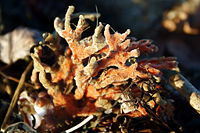
Sponges are asymmetrical animals—they cannot be sliced in any way that produces similar sides.
Animals, like other multicellular organisms, can be classified on their symmetry: can their bodies be sliced into nearly identical pieces? Animals are symmetrical on zero, one, two, or more planes of symmetry. Sponges, sea squirts, and similar animals are completely asymmetrical, but virtually every other animal is symmetrical in at least one plane. Asymmetrical animals tend to be fixed to a substrate and do not actively move; they feed passively and reproduce asexually or with external fertilization.

This sea star is an example of pentaradial symmetry: symmetry in five axes.
Organisms symmetrical on more than two planes are radially symmetrical; they appear like the spokes of a bicycle wheel, and most alive today float in water or attach to substrates. The echinoderms, such as sea stars and sea urchins, are radially symmetrical as adults, but as larvae they are bilaterally symmetric.
Organisms with only one plane are bilaterally symmetrical; they have left and right sides and two ends, and they tend to possess longer and narrower bodies. Virtually all bilaterally symmetrical animals are placed into the clade Bilateria and are descended from a single ancestor long ago. They also exhibit cephalization: the development of a head on one end of the body where feeding, sensory, and processing organs are concentrated. Bilateral symmetry and cephalization are both pervasive in animals—it seems that when they were developed, the diversity of animals exploded. It is thought that they enabled animals to more actively move, hunt, and respond to the environment better. [1]
Guts and body cavities
Animals may possess a gut. A gut is often described as a "tube with a tube": a long tube or chamber running through the body with one or more openings that can take in whatever food the animal consumes and digest it. The first opening, the gut's intake, is called the animal's mouth. If a gut has a second opening, on the other end of the tube, the opening is called an anus, and it is where remaining, undigested food is ejected. In radially symmetrical animals, the mouth is often found in the center. In bilaterally symmetrical animals, the mouth is usually in the head, nearby the animal's sensory organs, and the anus is likewise found on the opposite end of the head. Animals with only a mouth have a two-way gut (also called a blind gut), because food and waste must use the same opening. Animals with both mouths and anuses have a one-way gut, which can more efficiently process food and absorb nutrients.
Animals may also contain fluid-filled cavities inside their bodies, in which the gut and other organs may float. The cavity is called a either a coelom or pseudocoelom, depending on how it is sealed. enables an animal's internal organs to move independently in it, oxygen and nutrients to circulate within it, and an animal to move without limbs as a hydrostatic skeleton. Animals are often grouped by what kind of body cavity they have. Animals with coeloms are called coelomates, animals with pseudocoeloms are called pseudocoelomates, and animals that do not have any enclosed body cavity are called acoelomates.[1]
Body segmentation
Reproduction and life cycle
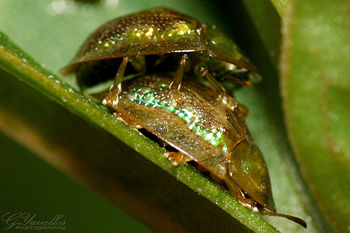
These two mating tortoise beetles are an example of internal fertilization.
Even though an animal may become especially efficient at moving and feeding, if it does not reproduce well, it may fail to make its traits more common. Thus, as with their feeding, locomotion, and body structure, animals reproduce and develop in astonishingly diverse ways. Many animals use sexual reproduction: they use meiosis to produce special cells called gametes, mate with another individual, and fuse their gametes together to form a new, genetically different individual. Some animals also can reproduce both asexually (creating clones of themselves using mitosis, without any mating involved). In addition, some animals such as the bdelloids can even only reproduce asexually.[1]
There are two types of sexual reproduction that may occur: internal or external fertilization. Fertilization refers to when a male gamete (called a sperm) fuses with a female gamete (called an ovum or egg) to form a whole new individual. A male animal performing internal fertilization usually insert a special organ into a female animal and transfers sperm inside. In some animals, females themselves insert packets of sperm produced by males into their bodies and fertilize them then. In seahorses, the usual internal fertilization occurs in reverse: females insert eggs into males' bodies, and the males fertilize them inside. Animals preforming external fertilization, in contrast, send both sperm and eggs into the environment, where they fuse outside either parents.
Origin and phylogeny
Animals are a clade, which means that all animals are linked through one common ancestor. A group of protists called the choanoflagellates are the closest living relatives to animals. In the past decade, molecular phylogeny has dramatically changed our understanding of the relationships among the many lineages of animals. Below is a summary of the currently widely accepted theory of the phylogeny of animals and how we group them to make sense of their bewildering diversity.
- The Porifera (sponges) of today are the closest, most basal animal phylum to the choanoflagellates and the first group among the surviving animals to separate from the rest. Like all animals, they possess multicellularity and epithelia, but are otherwise very different from the other animals below.
- True tissues, diploblasty, and symmetry separate the other animals from the sponges; the group of all non-sponge animals is called Metazoa.
- First up in Metazoa are the two phyla Cnidaria (jellyfish and sea anemones) and Ctenophora (comb jellies) contain animals that are radially symmetric and diploblastic.
- Eventually, some animal lineage developed bilateral symmetry, cephalization, and triploblasty. The animals descended from that lineage form a large group, called Bilateria.
- Classification of animals within Bilateria has undergone a radical reorganization in the past decades. Most animals in Bilateria now are split into two clades: the protostomes and the deuterostomes.
- Equally significantly, protostomes in turn are divided into two groups: the ecdysozoans and lophotrochozoans. These three groups have many fundamental differences, especially in how their embryos develop and how they grow. They are all described in more detail below.
Protostomes
The protostomes descend from one ancestor, and are distinguished by how their embryo cells form in a spiral.
Ecdysozoans
Lophotrochozoans
Deuterostomes
Animals in ecosystems
Because animals are heterotrophs, they act as consumers in whatever ecosystems they live in. They are often found at the higher trophic levels of their ecosystems' food webs: herbivores eat plants and other producers, carnivores and omnivores eat other consumers, and detrivores feed on any dead organisms. For the vast majority of animals, the usable energy that animals need to sustain their metabolism and stay alive originally comes from the Sun. This energy was captured by producers like plants with photosynthesis, which is turn transferred to whatever animals eat them.
Animals are also important links in many biochemical cycles. In the carbon and oxygen cycles, for instance, animals consume the oxygen gas produced by plants' photosynthesis and use it in aerobic respiration, producing carbon dioxide gas. Carbon dioxide is in turn required for photosynthesis—in this way plants and animals rely on each other for the carbon they require to grow. Animals free up the carbon that plants are made of by eating, burning, and exhaling carbon dioxide into the Earth's atmosphere and hydrosphere. Plants capture this airborne carbon and use it to build themselves up.
